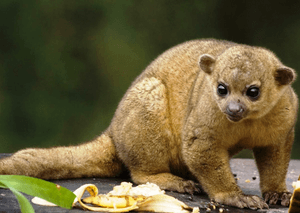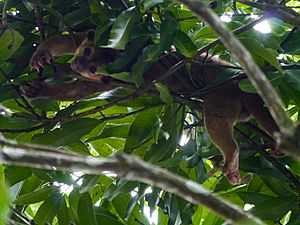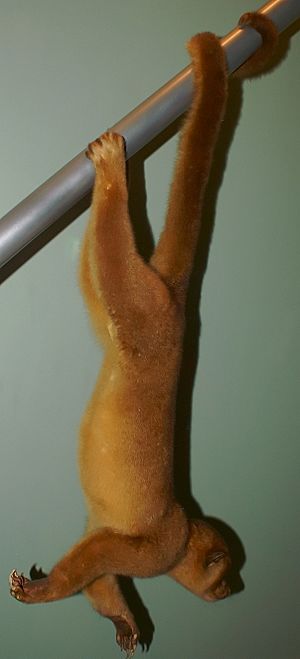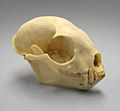Kinkajou facts for kids
Quick facts for kids Kinkajou |
|
|---|---|
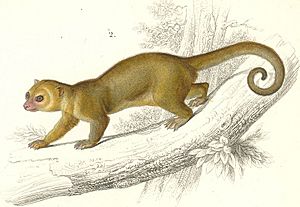 |
|
| Conservation status | |
| Scientific classification | |
| Kingdom: | |
| Class: | |
| Order: | |
| Family: | |
| Genus: |
Potos
Geoffroy Saint-Hilaire & Cuvier, 1795
|
| Species: |
P. flavus
|
| Binomial name | |
| Potos flavus (Schreber, 1774)
|
|
 |
|
| Kinkajou range | |
The kinkajou (Potos flavus) is a furry mammal that lives in tropical rainforests. It belongs to the same family as raccoons, coatis, and olingos.
The kinkajou is the only animal in its group, called Potos. People sometimes call it the "honey bear" because it loves sweet things. Kinkajous spend almost all their time in trees. They are not related to monkeys, but they are very good at climbing!
These animals live in Central America and South America. You might not see them often because they are active mostly at night. Kinkajous are not an endangered species, which means they are not at high risk of disappearing. However, they are sometimes hunted for their fur or meat, or to be kept as pets. Because of this, some countries like Honduras have rules about exporting them to protect them.
Contents
What Does a Kinkajou Look Like?
An adult kinkajou usually weighs between 1.4 and 4.6 kilograms (about 3 to 10 pounds). Its body can be 40 to 60 centimeters (16 to 24 inches) long. Plus, it has a long tail that is also 40 to 60 centimeters long!
Kinkajous have soft, woolly fur. It's usually golden or brownish-gray on the outside, with a gray layer underneath. They have big eyes that help them see in the dark and small ears. Their short legs have five toes on each foot, and they have sharp claws for climbing.
Where Do Kinkajous Live?
Kinkajous first appeared in Central America. Millions of years ago, they moved into South America. This happened when the Isthmus of Panama formed, creating a land bridge between the two continents.
You can find kinkajous from Mexico, through Central America, all the way to Bolivia and southeastern Brazil. They live in different kinds of tropical forests. This includes rainforests, mountain forests, and dry forests. Losing their forest homes due to Deforestation is a possible threat to them.
What Do Kinkajous Eat?
Even though kinkajous are part of the carnivore group, they mostly eat fruit. They especially love figs! When they eat soft fruits, they hold them with their front paws. Then, they use their long tongues to scoop out the soft inside. They help spread seeds around the forest.
About 10% of their diet comes from leaves, flowers, and other plants. Sometimes, they also eat insects, like ants. Kinkajous have a long, slender tongue, about 13 centimeters (5 inches) long. This tongue helps them get fruit and lick nectar from flowers. By doing this, they also help pollinate the flowers.
Kinkajou Behavior and Life Cycle
Kinkajous spend most of their lives high up in trees. They are very good at moving through the branches. Like raccoons, kinkajous are amazing climbers, almost as good as monkeys! They have a special tail that can grip things, like a "fifth hand." They use it to help them climb, but not to hold food.
They can also turn their ankles and feet all the way around (180 degrees). This makes it easy for them to run backward on branches and climb down trees headfirst. Kinkajous have special scent glands near their mouth, on their throat, and on their belly. They use these glands to mark their territory and their paths through the trees.
Kinkajous often sleep together in family groups. They also groom each other, which means they clean each other's fur. While they usually look for food alone, sometimes they forage in small groups.
Since they are nocturnal, kinkajous are most active between 7:00 PM and midnight. They also have another active period about an hour before the sun comes up. During the day, they sleep in hollow trees or in shady spots among leaves, away from direct sunlight.
Kinkajous can have babies at any time of the year. After about 112 to 118 days, the mother gives birth to one or sometimes two small babies. In zoos, kinkajous can live for about 23 years on average. The oldest recorded kinkajou lived to be 41 years old!
Kinkajous as Pets
Some people keep kinkajous as exotic pets. They can be playful, usually quiet, and don't have a strong smell. However, they can sometimes become aggressive. Kinkajous don't like sudden movements, loud noises, or being woken up during the day.
If a kinkajou gets upset, it might scream and attack. They usually scratch with their claws and can bite deeply. It's important to know that pet kinkajous can carry a type of roundworm. This worm can be dangerous to humans if it infects the brain.
Images for kids
See also
 In Spanish: Kinkajú para niños
In Spanish: Kinkajú para niños



